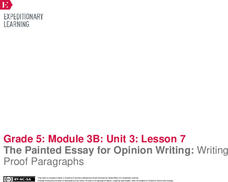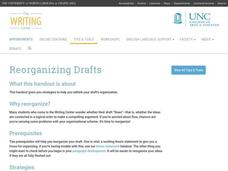Curated OER
The Paragraph
Review the components of a well-written paragraph with your class. Be sure your writers include a topic sentence supported with main ideas and followed by a conclusion. Unity, coherence, and transition words are emphasized. Experiment...
Curated OER
Paragraph Construction
What is a paragraph? This question drives the PowerPoint. Viewers discuss important elements of a solid paragraph, transitions between paragraphs, and strategies for editing. Show this presentation and then look at an example paragraph...
EngageNY
The Painted Essay for Opinion Writing: Writing Proof Paragraphs
It's time to proof read! Pupils read and analyze proof paragraphs from a model essay. They then practice writing their own proof paragraphs to express an opinion about offshore oil drilling.
Curated OER
Paragraph Development Exercise: Chronological Order
People use time to organize their days and structure their lives. Why not use it to structure a paragraph? Chronological order is logical and fairly straightforward. Ask class members to first read the provided example and then write...
Curated OER
Writing to Make a Point
Begin your persuasive writing with a helpful exercise on making points. With a list of ten points on transportation in a city, third graders map a logical order to their argument. They then write one or two paragraphs about the points...
For the Teachers
Story Strips Sequencing
What happens next? Work on story sequence with a lesson that prompts kids to put a story back in order. Additionally, they discuss what would happen if one event was missing from the sequence.
Curated OER
The Rest Cure: Gender in Medicine and Literature
Read and discuss "The Yellow Wall-Paper" and the gender issues that the story brings up. Use articles from the time period to analyze, complete with specific discussion questions. After two days, scholars write an essay based on topics...
For the Teachers
Sequence Plot Chart
Your kids can identify the plot sequence of a short story, but what about an informational article? Have them examine the chronological order of events in informational texts with a lesson on the sequence of events.
Mathematics Vision Project
Module 6: Congruence, Construction, and Proof
Trace the links between a variety of math concepts in this far-reaching unit. Ideas that seem very different on the outset (like the distance formula and rigid transformations) come together in very natural and logical ways. This unit...
University of North Carolina
Reorganizing Drafts
Poor organization often destroys an otherwise good paper. After writing a first draft, individuals consider the organization of ideas, a topic discussed in the 16th handout in the 24-part Writing the Paper series. The resource covers...
Curated OER
Let's Put You in a Louisiana University
Considering a college search project? After picking a possible career choice, and determining if that career needs a technical college or university education, individuals examine a wide variety of sources and select three schools that...
Curated OER
Car For Sale!
Car For sale! In this GED prep lesson, writers develop a classified advertisement to sell a car. After a discussion of precise words and phrases, telling details, and sensory language, sellers draft their ad for review, revision and...
Southern Nevada Regional Professional Development Program
Common Core Reading Standards: Understanding Argument
What does your class know about logical fallacies? They can find out quite a bit and practice identifying logical fallacies if you follow the steps and use the resources provided here! After reviewing ethos, pathos, and logos, ask small...
Curated OER
A Paragraph Organization Exercise
Students examine sentences and rewrite them in the most logical order. Each sentence should be connected to the next, both logically and rhetorically.They look for methods the author has used to organize and develop his ideas.
Think Like A Programmer! Puzzlets Cork the Volcano Curriculum
Common Core Standards Connected
The standards listed below are standards from the Common Core Framework which map to learning opportunities with Cork The Volcano & Puzzlets.
Source Link: http://www.corestandards.org/
Grade...
Curated OER
Narrative Nuts and Bolts
After viewing slides and reading about child labor, young authors compose an original narrative story. They practice note-taking skills and work to effectively engage a reader by incorporating plot, logical order, complex characters,...
For the Teachers
Cause and Effect Matrix
Study cause and effect in both literature and informational text with a lesson designed for several different reading levels. After kids review the concept of cause and effect, they read an article or story and note the causes and...
Curated OER
If I Could Have Lived in Another Time or Culture
Third graders develop multi-paragraph compositions. They include an introduction, first and second level support, and a conclusion. They use a variety of sentence structures (e.g., simple, compound/complex) and sentence types (i.e.,...
Shmoop
ELA.CCSS.ELA-Literacy.RI.11-12.3
Make analyzing the sequence of events in an informational text easy. Ask readers to craft a one-sentence summary of each paragraph in a document and create a text map. To demonstrate their understanding of the process, participants read...
Pennsylvania Department of Education
Tell Me Again
Students demonstrate how to retell a story in sequential order. In this reading comprehension instructional activity, students listen to a suggested read aloud, such as Little Boy Blue. Additionally, students practice retelling the story...
West Contra Costa Unified School District
Investigating Special Right Triangles
Scholars first investigate relationships in the side lengths of 30°-60°-90° triangles and 45°-45°-90° triangles. This knowledge then helps them solve problems later in the lesson about special right triangles.
Pennsylvania Department of Education
Informational Writing: Lesson 2 of 5
Introduce expository writing to your elementary learners. Young authors write a three-paragraph informational paper using the steps of the writing process. They follow guided lessons to experience each of five steps. Included are tons of...
Curated OER
Three Reasons Why I Want To Be...
Students investigate the process of writing an expository paper. The purpose of the paper is established in the introduction and the supporting details are sequenced in a logical order. The paper possesses punctuation and grammatical...
Pennsylvania Department of Education
6 Traits: Organization
Students make logical patterns in their writing to demonstrate the trait of organization. In this organization lesson plan, students focus on events proceeding logically.

























